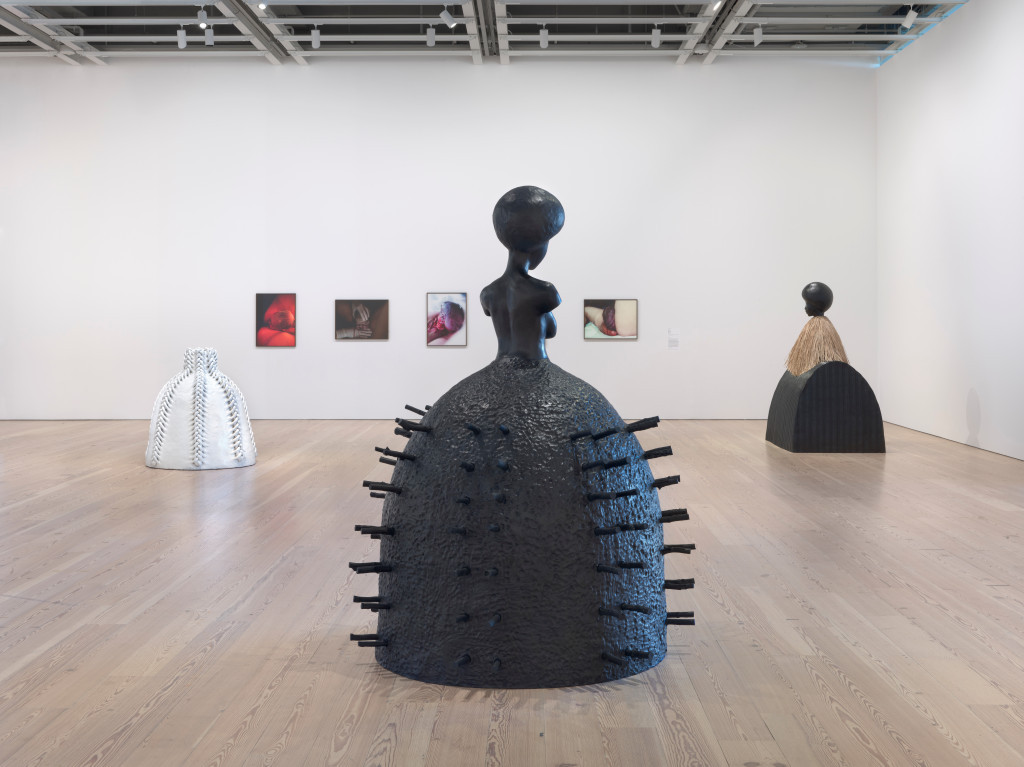[ad_1]
Although this year’s Whitney Biennial is officially a thing of the past, many of the works that were a part of it will live on in the collection of New York’s Whitney Museum, which has announced that it acquired 88 works from the show. That’s not all that’s headed to the Whitney’s holdings, however—over the course of the Whitney Biennial, the museum kept busy, adding more than 250 works between April and November. Below, a look at some of the works that recently entered the museum’s collection, from a 3D video that has been celebrated abroad to iconic works from the 2019 biennial.

©2016 Trust of Laura Aguilar/Whitney Museum
Laura Aguilar, Three Eagles Flying, 1990
The most well-known work by Laura Aguilar, who died last year at age 58, this photograph features the artist positioned between Mexican and American flags, with her hands bound and her body wrapped in emblems of both nations. It’s a powerful image of the double consciousness experienced by the Chicanx community of which she was a part, and one that ended up becoming emblematic of her influential work as a whole.

©Alex Da Corte and Jayson Musson/Ron Amstutz/Whitney Museum
Alex Da Corte, Easternsports, 2014
This piece, which featured prominently in a Whitney survey of expanded cinema in 2016, takes the form of a four-channel video that he has been termed a “multilingual soap opera.” First shown at the Institute of Contemporary Art Philadelphia as part of two-person exhibition with Jayson Musson, it features a number of brightly hued tableaux—a group of men playing beer pong in a decidedly wrong way, for one—that are by turns surreal and beautiful. It’s jointly owned by the Whitney and the Philadelphia Museum of Art.

Courtesy the artist and Company Gallery, New York/Whitney Museum
John Edmonds, Tête d’Homme, 2018
Among the most widely praised works to appear at the 2019 Whitney Biennial, this John Edmonds photograph is from the artist’s “Tribe” series, which features Black sitters next to African masks, in an attempt to disentangle the twisted legacy of Surrealism and its artists’ fetishistic penchant for objects from the continent. A similar work appear alongside one of the year’s most important art essays, “The Dominance of the White Male Critic,” a piece by Elizabeth Méndez Berry and Chi-hui Yang that appeared in the New York Times.

Courtesy the artist/Whitney Museum
Heji Shin, Baby 6, 2016
Having photographed a range of celebrities, from the Kardashians to Kanye West, Heji Shin has also turned her lens on less starry subjects—for her “Baby” series, she offers close-up shots of women giving birth. They are shockingly dead-on and, in some weird way, also rather transfixing.

©The Harrison Studio/Whitney Museum
The Harrisons, Survival Piece #5: Portable Orchard, 1972–73
Long before much of the art world began contemplating environmental issues, the Harrisons, a husband-and-wife artist duo that began working in California during the 1960s, were thinking through how art could be sustainable. With their “Survival Pieces,” which are regarded as some of the most important works related to the Land art movement, they engineered methods for creating produce in ecologically friendly ways. This one is an orchard filled with citrus trees that can be set up indoors.

Maximilíano Durón/ARTnews
Janiva Ellis, Uh Oh, Look Who Got Wet, 2019
One of largest works in the Whitney Biennial, Janiva Ellis’s Uh Oh, Look Who Got Wet features a person wading through a winding river, child in arms, while a half-nude woman lies on a bank nearby. All of their faces appear to be fractured, hinting at unresolved tensions.

©Clarissa Tossin/Whitney Museum
Clarissa Tossin, Ch’u Mayaa, 2017
Clarissa Tossin’s video Ch’u Mayaa, which previously appeared in the Whitney’s 2018 show “Pacha, Llaqta, Wasichay,” features a Puerto Rican dancer who writhes among the Mexican-inspired forms of Frank Lloyd Wright’s Hollyhock House, the first structure that the famed architect built in Los Angeles. Over the course of the video, amid the chopped-up sounds of shattering glass, she disappears. It’s a statement about cultural appropriation—who gets to be seen, and what happens to those that aren’t.

©2018 Camille Henrot/Courtesy the artist and Metro Pictures, New York
Camille Henrot, Saturday, 2017
A Camille Henrot show that spanned the full of Paris’s gargantuan Palais de Tokyo museum in 2017 unfortunately never made its way to the United States, though this 3D video from it has thankfully made its way into the Whitney collection. In it, Henrot ponders how, amid all kinds of information overload, we make time to relax. Her arresting semi-documentary features images of people praying alongside a faux news broadcast with a ticker that leaps out of the screen.

Ron Amstutz
Simone Leigh, Stick, 2019
One of three new sculptures by the artist that appeared in the 2019 Whitney Biennial, this work, with its elegant allusions to a variety of sources, from West African adobe structures to ancient Egyptian art, is a characteristic one for Leigh. It features a nude woman whose form is merged with a dress that seems to emit spikes; the artist has said her target audience for it is Black women.

Courtesy the artists; Team Gallery, New York; Document Gallery, Chicago; and Susanne Vielmetter Los Angeles Projects, Los Angeles/Whitney Museum
Ariel Goldberg, Camera Lesson, 2018
Most artists choose to work solo when creating art for the Whitney Biennial, but for his presentation at the 2019 edition, photographer Paul Mpagi Sepuya enlisted the help of his friends to create pictures that were shot using mirrors. In this work, Sepuya appears alongside critic Ariel Goldberg, to whom the work is credited. They both wield their cameras at a reflective surface, and it’s only the work’s wall label that makes clear that Goldberg’s was the one that produced this image.
[ad_2]
Source link

